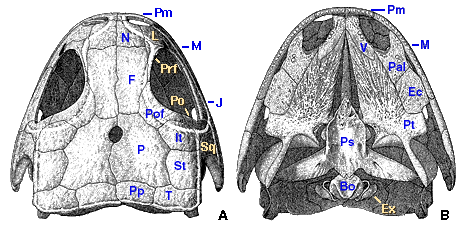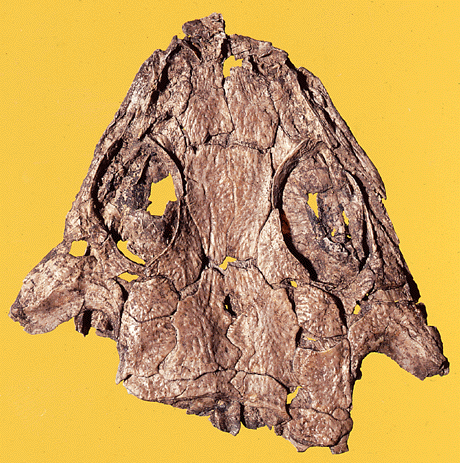Discosauriscus
Jozef Klembara
- Discosauriscus pulcherrimus

- Discosauriscus austriacus

Introduction
Several hundred specimens of Discosauriscus have been found in the Lower Permian deposits of Central and West Europe. The skeletons preserved in the lacustrine deposits of the Boskovice Furrow in Moravia (Czech Republic) are the best preserved specimens (Klembara and Meszáros, 1992). Discosauriscus is known from larval, metamorphic and early juvenile specimens; no adult individuals are known (Klembara, 1995a).
Discosauriscus includes two valid species (Klembara, in preparation): D. austriacus (Makowsky, 1876), the best known species from the Boskovice Furrow, and D. pulcherrimus (Fritsch, 1879), represented by a few specimens from the Boskovice Furrow, and several individuals from north Bohemia (Czech Republic), Germany (Werneburg, 1985), Poland (Werneburg, personal communication) and France (Heyler, 1969).
Characteristics
The following ontogenetic stages can be distinguished in the material of D. austriacus (SL = skull length): larval (SL: up to 30 mm), metamorphic (SL: 30-50 mm), and early juvenile (SK: 50-62 mm). Only about five specimens represent the early juvenile stage. Most specimens represent the metamorphic stage.
The lateral-line system is well preserved (Klembara, in press). In addition to sensory grooves in the dermal bones, there are also pit-lines (Klembara, 1992, 1994b) and foraminate pits. The latter are present in the skull roof bones; these pits probably housed clusters of ampullary electroreceptive organs and are homologous with the pore-groups in osteolepiforms (Klembara, 1994b).
There is no kinetic line between the skull table and the cheek. The rectangular tabular process is probably homologous with the tabular horn of embolomeres (Fig. 1). The jugal is exposed on the ventral skull margin. There was no interpremaxillary fenestra. A postorbital-supratemporal contact is occasionally present (Klembara, 1994a). The labyrinthine infolding characteristic of many early terrestrial vertebrates only appears in the late larval stage. One to four palatal tusts can be found on each vomer, and one to five on the palatine. The palate is closed in early juveniles, but earlier ontogenetic stages retain a narrow interpterygoid vacuity. The transverse flange of the pterygoid sweeps slightly below the ventral margin of the cheek. A suborbital fenestra is present. The laterally expanded otic tubes found in other seymouriamorphs remain cartilaginous in all known specimens. Two small Meckelian fenestrae pierce the medial surface of the lower jaw. All three coronoids bear small teeth. The dentary bears up to 43 teeth. The quadrate and articular are unossified in all specimens. Many specimens have subdivided or fused skull roof bones (Klembara, 1993, 1995b).


Figure 1. Cranial reconstruction of a larva of Discosauriscus in dorsal (A) and palatal (B) view. Abbreviations: Bo, basioccipital; Ec, ectopterygoid; Ex, exoccipital; F, frontal; It, intertemporal; J, jugal; L, lacrimal; M, maxilla; N, nasal; P, parietal; Pal, palatine; Pm, premaxilla; Po, postorbital; Pof, postfrontal; Pp, postparietal; Prf, prefrontal; Ps, parasphenoid; Pt, pterygoid; St, supratemporal; T, tabular; V, vomer. Drawings by Mr. J. Gullar.
There are 24 presacral vertebrae. The single sacral vertebra has a massive sacral rib. At metamorphosis, the neural arches are similar to those of embolomeres, but in early juveniles, they are already swollen (contra Heaton, 1980) and almost completely fused with the large pleurocentrum. The dermal shoulder girdle elements include the interclavicle (with a long parasternal process), paired clavicles (with relatively broad ventral plates), and slender, cylindrical cleithra. Endoskeletal components include scapula (with a stout supraglenoid buttress and a large supraglenoid foramen) and coracoid (with distinct coracoid foramen). The phalangeal formula is 2-3-4-5-3 for manus and pes.
Rounded scales with concentric rings covered the body from all sides (Spinar, 1952; Klembara and Meszáros, 1992).
References
Fritsch A. 1879. Neue Übersicht der in der Gaskohle und den Kalksteinen der Permformation in Böhmen vorgefundenen Tierreste. Sitzungsberichte der königlichen böhmischen Gesselschaft der Wissenschaften (Prag 1879), 184-195.
Heaton M. J. 1980. The Cotylosauria: A Reconsideration of a Group of Archaic Tetrapods. In: A. L. Panchen (ed.) The Terrestrial Environment and the Origin of Land Vertebrates: 497-551. London: Academic Press.
Heyler D. 1969. Vertébrés de l'Autunien de France. Vol. 1. Cahiers de paléontologie, ed. J. P. Lehman. Paris: CNRS.
Klembara J. 1992. The first record of pit-lines and foraminal pits in tetrapods and the problem of the skull roof bones homology between tetrapods and fishes. Geologica carpathica 42: 249-252.
Klembara J. 1993. The subdivisions and fusions of the exoskeletal skull bones of Discosauriscus austriacus (Makowsky 1876) and their possible homologues in rhipidistians. Paläontologische Zeitschrift 67: 145-168.
Klembara J. 1994a. The sutural pattern of skull-roof bones in Lower Permian Discosauriscus austriacus from Moravia. Lethaia 27: 85-95.
Klembara J. 1994b. Electroreceptors in the Lower Permian tetrapod Discosauriscus austriacus. Palaeontology 37: 609-626.
Klembara J. 1995a. The external gills and ornamentation of skull roof bones of the Lower Permian tetrapod Discosauriscus (Kuhn 1933) with remarks to its ontogeny. Paläontologische Zeitschrift 69: 265-281.
Klembara J. 1995b. Some cases of fused and concrescent exocranial bones in the Lower Permian seymouriamorph tetrapod Discosauriscus Kuhn 1933. In: H. Lelièvre, S. Wenz, A. Blieck and R. Cloutier (eds.) Premiers vertébrés et vertébrés inférieurs (Geobios mémoire spécial no. 19), pp. 263-267.
Klembara, J. In press. The lateral line system of Discosauriscus austriacus (Makowsky 1876) and the homologization of skull roof bones between tetrapods and fishes. Palaeontographica A.
Klembara, J. In preparation. The cranial anatomy of Discosauriscus from the Upper Permian of the Boskovice Furrow.
Klembara J. & S. Meszáros. 1992. New finds of Discosauriscus austriacus (Makowsky 1876) from the Lower Permian of Boskovice furrow (Czecho-Slovakia). Geologica Carpathica 43: 305-312.
Makowsky A. 1876. Über einen neuen Labyrinthodonten "Archegosaurus austriacus nov. spec.". Sitzungsberichte der kaiserlichen Akademie der Wissenschaft 73: 155-166.
Spinar Z. 1952. Revision of some Moravian Discosauriscidae. Rozpravy Ustredního ustavu geologického 15: 1-159.
Werneburg R. 1985. Zur Taxonomie der jungpaläozoischen Familie Discosauriscidae Romer 1947 (Batrachosauria, Amphibia). Freiberger Forschungshefte, Reihe C 400: 117-139.
About This Page
I am thankful to Dr. M. Laurin (University of California, Berkeley) for editing this page and scanning the illustrations.

Comenius University, Bratislava, Slovakia
Correspondence regarding this page should be directed to Jozef Klembara at
Page copyright © 1996
 Page: Tree of Life
Discosauriscus.
Authored by
Jozef Klembara.
The TEXT of this page is licensed under the
Creative Commons Attribution License - Version 3.0. Note that images and other media
featured on this page are each governed by their own license, and they may or may not be available
for reuse. Click on an image or a media link to access the media data window, which provides the
relevant licensing information. For the general terms and conditions of ToL material reuse and
redistribution, please see the Tree of Life Copyright
Policies.
Page: Tree of Life
Discosauriscus.
Authored by
Jozef Klembara.
The TEXT of this page is licensed under the
Creative Commons Attribution License - Version 3.0. Note that images and other media
featured on this page are each governed by their own license, and they may or may not be available
for reuse. Click on an image or a media link to access the media data window, which provides the
relevant licensing information. For the general terms and conditions of ToL material reuse and
redistribution, please see the Tree of Life Copyright
Policies.
Citing this page:
Klembara, Jozef. 1996. Discosauriscus. Version 01 January 1996. http://tolweb.org/Discosauriscus/17544/1996.01.01 in The Tree of Life Web Project, http://tolweb.org/









 Go to quick links
Go to quick search
Go to navigation for this section of the ToL site
Go to detailed links for the ToL site
Go to quick links
Go to quick search
Go to navigation for this section of the ToL site
Go to detailed links for the ToL site